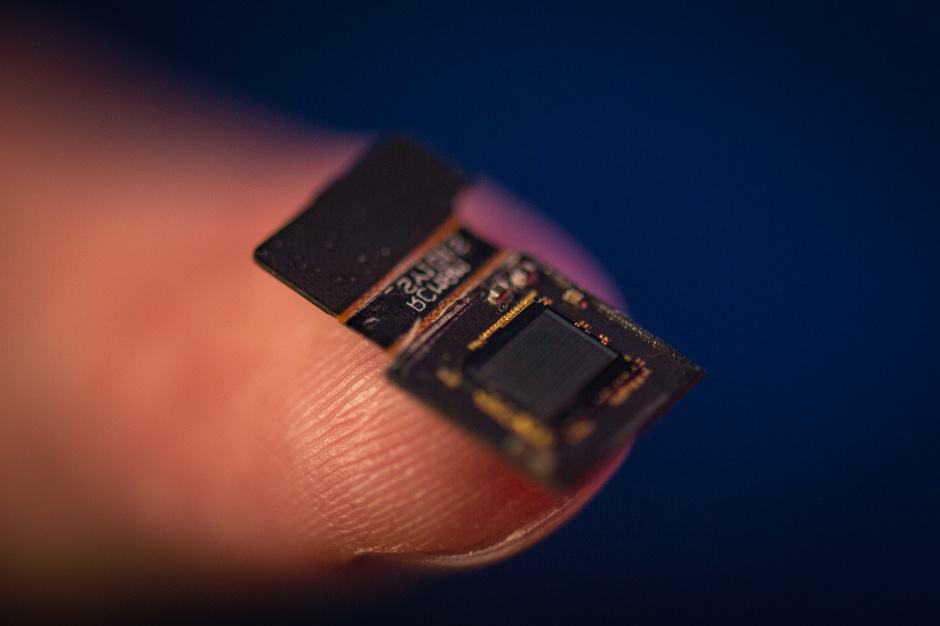Microscopes have existed for over 350 years but the latest development would not be recognisable to the pioneers of studying the smallest scales. A team from Rice University in Houston, Texas, which has been specialising in lens-free optics, has made an important advance in freeing microscopes from their defining component. Their primary targets are medical uses.

The team, led by Richard Baraniuk, has made a microscope mounted on a microchip small enough to sit in a fingertip, and yet capable of micron resolution. It gets past a limitation that has dogged microscopy for years: a trade-off where arrays of lenses can either gather less light from a large field of view or more light from a much smaller field.
The Rice team, which works across labs led by Baraniuk, Ashok Veeraraghavan and Jacob Robinson, had previously developed a lens-free completely flat camera, which they named FlatCam. Developing this work with the hope of turning into a high resolution neural interface that could be implanted between brain and skull, they realised that it could have more potential as a flat microscope, which with the same nominative flair, they have named FlatScope.
FlatScope is a fluorescent microscope, which is a type of instrument increasingly used in biology. They pick up fluorescent signals from particles inserted into cells and tissues that are illuminated with specific wavelengths of light. This allows researchers to track biological agents within living tissues at very small resolutions. The microscopes, however, are not small. Dependent on the size of their lenses, very high resolution microscopes are large and heavy, which limits their use.
The Rice team is instead looking at applications of electronic optics. Like digital cameras, they are using arrays of light-sensitive chips called Charge-Coupled Devices (CCDs). These arrays can be as large or small as required, with the size equating to the device’s field of view.
Both FlatCam and FlatScope borrow a feature from the most basic type of lens free camera: the pinhole camera. Instead of a pinhole, they use a customised amplitude mask to focus light onto the CCD. This mask, which sits just in front of the CCD, is a grid of differently sized clear and opaque squares, somewhat resembling a two-dimensional QR code. Light that passes through the clear squares and hits the CCD becomes data that can then be interpreted by a computer algorithm. This algorithm can focus on any part of the data that the CCD captures and produce images of objects of micron scale anywhere in the field.
It is this resolution that is the difference between that can FlatCam and FlatScope, and producing this resolution required redesigning the aptitude mask to reduce the amount of light that reaches the sensor. Placed only a few hundred micrometres from the CCD, it allows only a very small fraction of the light through. This reduces the amount of data that the algorithm has to process.
"In the case of a megapixel camera, that computational problem requires a matrix of a million times a million elements," said Robinson. "It's an incredibly big matrix. But because we break it down through this pattern of rows and columns, our matrix is just one million elements."
This reduces the amount of data for each image from 6TB down to 21MB, which means the processing times for the images are short. In an open access paper in the journal Science Advances, the team claims that FlatScope can capture 30 frames of 3D data per second.
As well as being compact, FlatScope has the potential to be very cheap. "One of the big advantages of this technology compared with traditional cameras is that because we don't need lenses, we don't need post-fabrication assembly," said Veeraraghavan. "We can imagine this rolling off a fabrication line."
This would make the device available for applications such as swallowable endoscopes or palm-sized microscopes that could be used by doctors in in disaster or conflict zones. Although the current version of FlatScope is a fluorescence microscope, the technology could also be used for bright-field, dark-field or reflected light microscopy, the team claims.




April 1886: the Brunkebergs tunnel
First ever example of a ground source heat pump?